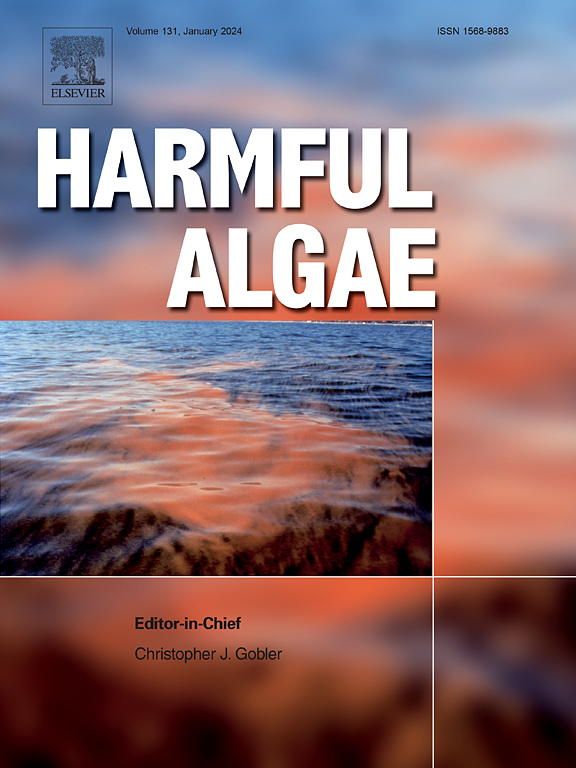底栖越冬蓝藻种子群对河口水华动态的影响
IF 5.5
1区 生物学
Q1 MARINE & FRESHWATER BIOLOGY
引用次数: 0
摘要
蓝藻华(cHABs)由潜在有毒的微囊藻蓝藻组成,在世界范围内的水体中正在增加。河口的chab通常起源于水力停留时间较长的上游位置(如水库、静态通道)。这些地方也积累了更高浓度的底栖越冬细胞,作为次年繁殖的接种物。我们调查了在水文复杂的旧金山河口上游,也被称为萨克拉门托-圣华金三角洲(三角洲)越冬的微囊藻种子库。采用定量聚合酶链反应(qPCR)定量测定了夏季藻华可接种的沉积物中微囊藻总数。为了研究水华的起源和演替,使用蓝藻特异性16S-23S ITS rDNA引物对离散水和沉积物样品中的DNA进行PCR扩增。结果证实了静态周边地区的种子储量最高,地表水中微囊藻浓度普遍最高的假设。在沉积物和水柱中检测到36种独特的基因型,证实了三角洲微囊藻种群具有较高的遗传多样性。这项研究表明,越冬细胞应考虑研究微囊藻动力学跨大型河口系统。本文章由计算机程序翻译,如有差异,请以英文原文为准。

Role of benthic overwintering cyanobacteria seed stock on estuarine bloom dynamics
Cyanobacteria blooms (cHABs) comprised of the potentially toxic cyanobacterium Microcystis, are increasing in waterbodies worldwide. CHABs in estuaries often originate from upstream locations with longer hydraulic residence times (e.g., reservoirs, static channels). These locations also accumulate higher concentrations of benthic overwintering cells that serve as inoculum for subsequent year's blooms. We investigated overwintering Microcystis seed stock in the hydrologically complex upper San Francisco Estuary also known as the Sacramento-San Joaquin Delta (Delta). Quantitative polymerase chain reaction (qPCR) was used to quantify total Microcystis in the sediments that was available to inoculate summertime blooms. To study bloom origin and succession, DNA from discrete water and sediment samples was PCR amplified using cyanobacteria-specific 16S-23S ITS rDNA primers. Results confirmed the hypothesis that static peripheral areas have the highest seed stock and generally the highest Microcystis concentrations in surface water. We also confirmed high genetic diversity of the Microcystis population in the Delta with 36 unique genotypes detected in the sediment and water column. This study demonstrates that overwintering cells should be considered when investigating Microcystis dynamics across large estuarine systems.
求助全文
通过发布文献求助,成功后即可免费获取论文全文。
去求助
来源期刊

Harmful Algae
生物-海洋与淡水生物学
CiteScore
12.50
自引率
15.20%
发文量
122
审稿时长
7.5 months
期刊介绍:
This journal provides a forum to promote knowledge of harmful microalgae and macroalgae, including cyanobacteria, as well as monitoring, management and control of these organisms.
 求助内容:
求助内容: 应助结果提醒方式:
应助结果提醒方式:


